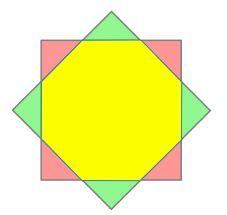Overlapping Squares.
 The above figure is formed from two squares of area
9
. They both have the same center. What is the area of the yellow part?
The above figure is formed from two squares of area
9
. They both have the same center. What is the area of the yellow part?
This section requires Javascript.
You are seeing this because something didn't load right. We suggest you, (a) try
refreshing the page, (b) enabling javascript if it is disabled on your browser and,
finally, (c)
loading the
non-javascript version of this page
. We're sorry about the hassle.
4 solutions
Thank you. Nice solution.
A square with an area of 99 has a side of 33 and an apothem of a = \frac{3}{2}a=
2
3
. The yellow part is a regular octagon with the same apothem as the square, with an area of A = na^2 \tan \frac{180°}{n} = 8(\frac{3}{2})^2 \tan \frac{180°}{8} \approx \boxed{7.46}A=na
2
tan
n
180°
=8(
2
3
)
2
tan
8
180°
≈
7.46
A square with an area of 9 has a side of 3 and an apothem of a = 2 3 . The yellow part is a regular octagon with the same apothem as the square, with an area of A = n a 2 tan n 1 8 0 ° = 8 ( 2 3 ) 2 tan 8 1 8 0 ° ≈ 7 . 4 6 .
Thank you, nice solution.
A square with an area of 9 9 has a side of 3 3 and an apothem of
a
3
2
a=
2
3
. The yellow part is a regular octagon with the same apothem as the square, with an area of
A
n a 2 tan 180 °
n
8
(
3
2
)
2
tan
180
°
8
≈
7.46
A=na
2
tan
n
180°
=8(
2
3
)
2
tan
8
180°
≈
7.46
.
We note that the area of the yellow region is the area of the square minus the area of four pink triangles. Since two pink triangles form a square of side length a . Then, A yellow = 9 − 2 a 2 = 9 − 2 ( 2 + 2 3 ) 2 ≈ 7 . 4 6 .